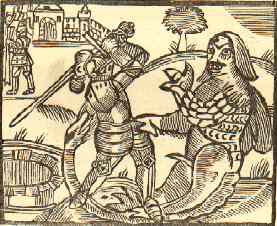Saint George
St. George was originally a soldiers' saint of the Eastern Church, but in the late Middle Ages he was chosen as the patron saint of English kings.
The emblem of George and the dragon was adopted by the Order of the Garter, an elite chivalric society founded by Edward III in the mid- fourteenth century. At a time when England was emerging as a nation, the soldier saint became a symbol of patriotism*.
The Golden Legend
The Golden Legend tells of St. George's birth in Cappadocia [a territory in eastern central Asia Minor] and the highlights of his career as a "knyght": he converted the city of Sylene to Christianity by saving it from a dragon; then preached against pagan idol-worship during the reign of Emperor Diocletian (284-305), when Christians were severely persecuted; finally, he became a martyr, tortured and decaptitated by the Roman provost Dacyen.
The legend also recounts briefly St. George's appearance during the First Crusade (1095-99), when, dressed in white armour marked with a red cross, he led the "liberation" of Jerusalem from the Muslims. More about "this blessyd and holy martyr . . ."*.
Glasgow University Library has images from their manuscript of the Golden Legend.
Footnotes
-
". . . Harry, England, and Saint George!"
That heroic English king, Henry V calls on his patron saint before the battle of Harfleur:
Once more unto the breach, dear friends, once more. . . .
Follow your spirit; and upon this charge,
Cry, "God for Harry, England, and Saint George!"
(Henry V 3.1.1.33-4)
Edmund Spenser's Redcrosse Knight, in The Faerie Queene, is patterned on Saint George. The illustration here could fit the final canto of Book One: Redcrosse fights, while Una (and her parents safe in the castle) look on.
-
Saynt George of Englonde
This blessyd and holy martyr saynt George is patrone of this royame of Englonde and the crye of men of warre. In the worshyp of whome is founded the noble ordre of garter and also a noble college in the castell of Wyndesore by kynges of Englonde in whiche college is the herte of saynt George whiche Sygysmonde the emperour of Almayne [Germany] brought and gaue it for a grete and precyous relyque to kynge Harry the fyfte. . . . Thenne lete vs praye vnto hym that he be specyall protector and defensor of this royame.
(From a 1512 translation of Legenda Aurea, The Golden Legend, by Wynkyn the Worde, who was a colleague of William Caxton and the inheritor of his printing business.)Unfortunately there is no historical evidence of Saint George's existence; even in the Middle Ages he was considered a questionable, or apocryphal, saint, and he was later removed from the canon. His feast day, April 23rd, may have been the date of Shakespeare's birth in 1564.
